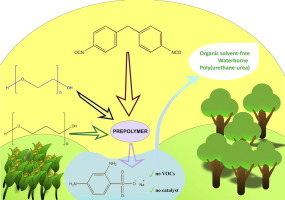当前位置:
X-MOL 学术
›
Eur. Polym. J.
›
论文详情
Our official English website, www.x-mol.net, welcomes your feedback! (Note: you will need to create a separate account there.)
Synthesis and characterization of environmentally-friendly waterborne poly(urethane-urea)s
European Polymer Journal ( IF 6 ) Pub Date : 2018-02-01 , DOI: 10.1016/j.eurpolymj.2017.12.026 Iñigo Díez-García , Arantzazu Santamaría-Echart , Arantxa Eceiza , Agnieszka Tercjak
European Polymer Journal ( IF 6 ) Pub Date : 2018-02-01 , DOI: 10.1016/j.eurpolymj.2017.12.026 Iñigo Díez-García , Arantzazu Santamaría-Echart , Arantxa Eceiza , Agnieszka Tercjak

|
Abstract In this work, corn-based 100% renewable carbon poly(trimethylene ether glycol) (P3MG), biodegradable and biocompatible poly(ethylene oxide) (PEO), 4,4′-diphenylmethane diisocyanate (MDI) and sodium 2,4-diamino-benzenesulfonate (SDBS) were used to synthesize novel biobased waterborne poly(urethane-urea) (WPUU) dispersions following an environmentally-friendly process, which avoids the use of organic solvent. The particle size of WPUU dispersions were determined by dynamic light scattering. The molar ratio of PEO/P3MG polyols was varied to identify the WPUU dispersion with the optimum equilibrium between renewable content and final properties. Increase of P3MG content in polyol mixture led to smaller particle size, what could be related to the hydrophilic character of PEO. All investigated WPUU films were characterized by means of their physicochemical, thermal and mechanical properties, as well as their morphology by atomic force microscopy. Higher P3MG content in the WPUU films led to phase separation at the nanoscale, higher glass transition temperature and T1 endotherm temperature induced by the decrease in the hydrogen bonding between soft segment and hard segment. Moreover, higher P3MG content also resulted in higher modulus and elongation at break of the WPUU films. The present work highlights that waterborne poly(urethane-urea) dispersions with promising properties can be successfully prepared without using any catalyst and organic solvent.
中文翻译:

环保型水性聚(氨酯-脲)的合成与表征
摘要 在这项工作中,玉米基 100% 可再生碳聚(三亚甲基醚二醇)(P3MG)、可生物降解和生物相容性聚(环氧乙烷)(PEO)、4,4'-二苯基甲烷二异氰酸酯(MDI)和 2,4-二氨基苯磺酸盐 (SDBS) 用于合成新型生物基水性聚(氨基甲酸酯 - 脲)(WPUU)分散体,采用环保工艺,避免使用有机溶剂。WPUU 分散体的粒径通过动态光散射测定。改变 PEO/P3MG 多元醇的摩尔比以确定 WPUU 分散体,在可再生成分和最终性能之间达到最佳平衡。多元醇混合物中 P3MG 含量的增加导致粒径变小,这可能与 PEO 的亲水特性有关。所有研究的 WPUU 薄膜都通过其物理化学、热和机械性能以及原子力显微镜的形态进行表征。WPUU 薄膜中较高的 P3MG 含量导致纳米级的相分离、较高的玻璃化转变温度和 T1 吸热温度,这是由软段和硬段之间的氢键减少引起的。此外,更高的 P3MG 含量也导致 WPUU 膜的更高模量和断裂伸长率。目前的工作强调,可以在不使用任何催化剂和有机溶剂的情况下成功制备具有良好性能的水性聚(氨基甲酸酯 - 脲)分散体。WPUU 薄膜中较高的 P3MG 含量导致纳米级的相分离、较高的玻璃化转变温度和 T1 吸热温度,这是由软段和硬段之间的氢键减少引起的。此外,更高的 P3MG 含量也导致 WPUU 膜的更高模量和断裂伸长率。目前的工作强调,可以在不使用任何催化剂和有机溶剂的情况下成功制备具有良好性能的水性聚(氨基甲酸酯 - 脲)分散体。WPUU 薄膜中较高的 P3MG 含量导致纳米级的相分离、较高的玻璃化转变温度和 T1 吸热温度,这是由软段和硬段之间的氢键减少引起的。此外,更高的 P3MG 含量也导致 WPUU 膜的更高模量和断裂伸长率。目前的工作强调,可以在不使用任何催化剂和有机溶剂的情况下成功制备具有良好性能的水性聚(氨基甲酸酯 - 脲)分散体。
更新日期:2018-02-01
中文翻译:

环保型水性聚(氨酯-脲)的合成与表征
摘要 在这项工作中,玉米基 100% 可再生碳聚(三亚甲基醚二醇)(P3MG)、可生物降解和生物相容性聚(环氧乙烷)(PEO)、4,4'-二苯基甲烷二异氰酸酯(MDI)和 2,4-二氨基苯磺酸盐 (SDBS) 用于合成新型生物基水性聚(氨基甲酸酯 - 脲)(WPUU)分散体,采用环保工艺,避免使用有机溶剂。WPUU 分散体的粒径通过动态光散射测定。改变 PEO/P3MG 多元醇的摩尔比以确定 WPUU 分散体,在可再生成分和最终性能之间达到最佳平衡。多元醇混合物中 P3MG 含量的增加导致粒径变小,这可能与 PEO 的亲水特性有关。所有研究的 WPUU 薄膜都通过其物理化学、热和机械性能以及原子力显微镜的形态进行表征。WPUU 薄膜中较高的 P3MG 含量导致纳米级的相分离、较高的玻璃化转变温度和 T1 吸热温度,这是由软段和硬段之间的氢键减少引起的。此外,更高的 P3MG 含量也导致 WPUU 膜的更高模量和断裂伸长率。目前的工作强调,可以在不使用任何催化剂和有机溶剂的情况下成功制备具有良好性能的水性聚(氨基甲酸酯 - 脲)分散体。WPUU 薄膜中较高的 P3MG 含量导致纳米级的相分离、较高的玻璃化转变温度和 T1 吸热温度,这是由软段和硬段之间的氢键减少引起的。此外,更高的 P3MG 含量也导致 WPUU 膜的更高模量和断裂伸长率。目前的工作强调,可以在不使用任何催化剂和有机溶剂的情况下成功制备具有良好性能的水性聚(氨基甲酸酯 - 脲)分散体。WPUU 薄膜中较高的 P3MG 含量导致纳米级的相分离、较高的玻璃化转变温度和 T1 吸热温度,这是由软段和硬段之间的氢键减少引起的。此外,更高的 P3MG 含量也导致 WPUU 膜的更高模量和断裂伸长率。目前的工作强调,可以在不使用任何催化剂和有机溶剂的情况下成功制备具有良好性能的水性聚(氨基甲酸酯 - 脲)分散体。



























 京公网安备 11010802027423号
京公网安备 11010802027423号